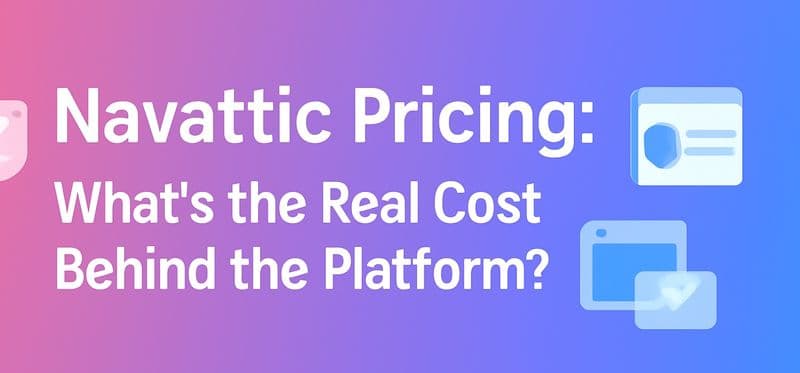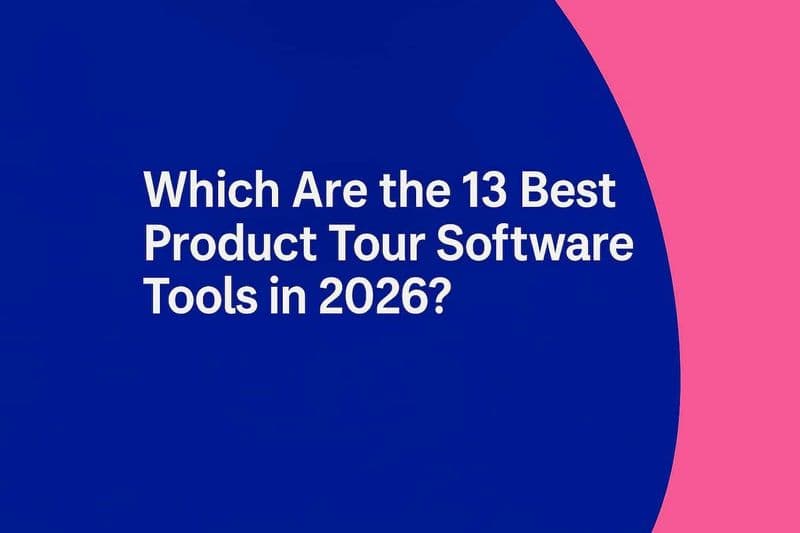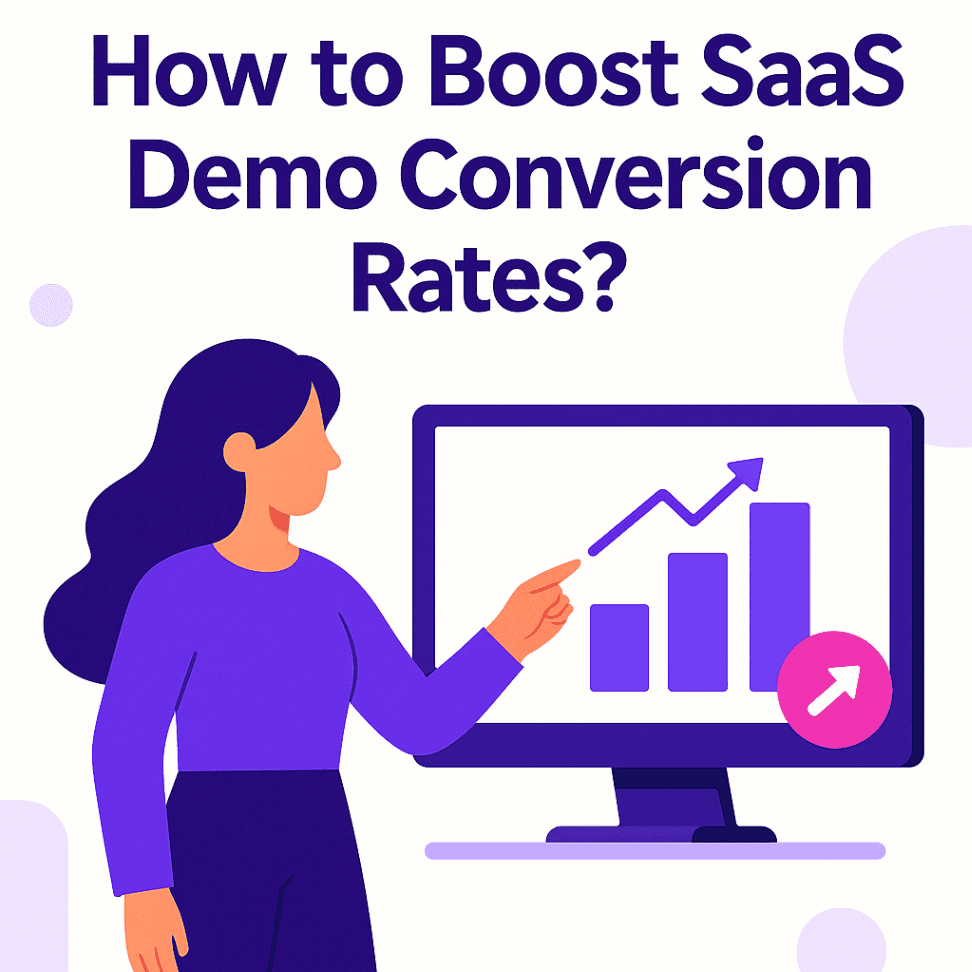
TL;DR
|
You’ve built a great SaaS product. A prospect books a demo, you walk them through the features… and then silence. No sign-up. No deal.
The truth? Booking demos is easy. Converting them is the real challenge. Most prospects don’t want a product tour; they want to see how your solution fixes their problems. Without personalization and engagement, even the best demos fall flat.
This guide breaks down expert strategies to turn your demos into revenue-driving conversations.
What is the Demo Conversion Rate For SaaS?
Google's overview suggests that, usually, 15%-30%.
Your demo conversion rate is more than just a number; it’s the clearest indicator of whether your SaaS go-to-market efforts are actually working.
Think about it: you’ve secured the meeting, guided the prospect through your product, answered every question… only to be faced with "let me get back to you on this". That silence is telling you something: your demo isn’t making the leap from interesting to indispensable.
A low conversion rate usually signals one of two things:
The demo isn’t showing immediate, tangible value.
Or it’s not mapping your product’s benefits to the prospect’s real-world problems.
It’s no different from a free trial that’s clunky or uninspiring; users won’t stay. If your demo feels like a feature parade instead of a solution showcase, prospects will quietly disengage.
High-converting demos go beyond features. They tell a story, build trust, and make the “next step” feel obvious. When you tailor your demo to specific use cases, highlight the business impact, and remove friction in the follow-up process, you turn interest into predictable revenue growth, not just lucky wins.
B2B vs. B2C: Why Do SaaS Demo Conversion Rates Differ?
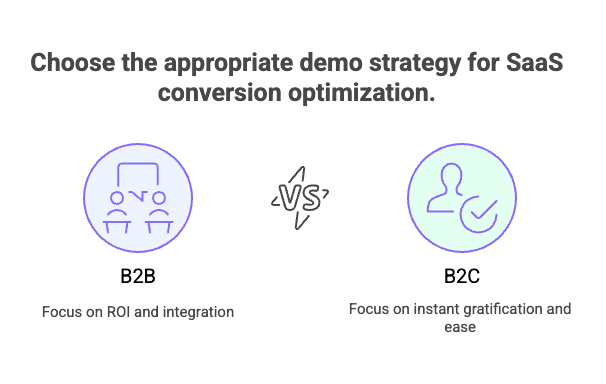
Not all SaaS demos play by the same rules. A solo entrepreneur testing a design tool won’t evaluate it the same way a CFO would with enterprise software. That’s why understanding the differences between B2B and B2C demo strategies is important for optimizing conversion rates.
B2B Demo Strategy
B2B sales are rarely a one-person decision; they’re more like a committee meeting. Multiple stakeholders, longer decision cycles, and higher price tags mean your demo needs to act as a business case, not just a product tour. Focus on:
Quantifiable ROI (efficiency, cost savings, productivity gains)
Smooth integration into existing workflows
Addressing the priorities of each decision-maker
Strong, multi-threaded follow-ups to keep momentum alive
B2C Demo Strategy
B2C conversions happen at lightning speed at every conversion funnel stage. Prospects either see value right away, or they disappear. That means your demo or free trial must deliver instant gratification and prompt immediate action, making sign-up effortless. To win here, focus on:
Ease of use and quick wins
Frictionless onboarding (no credit card walls)
Clear, compelling CTAs that drive action immediately
Typical Conversion Benchmarks
Customer Type | Benchmark Conversion Rate |
|---|---|
B2B SaaS | Lower initially (longer cycles, more stakeholders) |
B2C SaaS | Generally higher, often 3–5% |
What are the Analytics and Metrics to Track for Improved Conversion Rates?
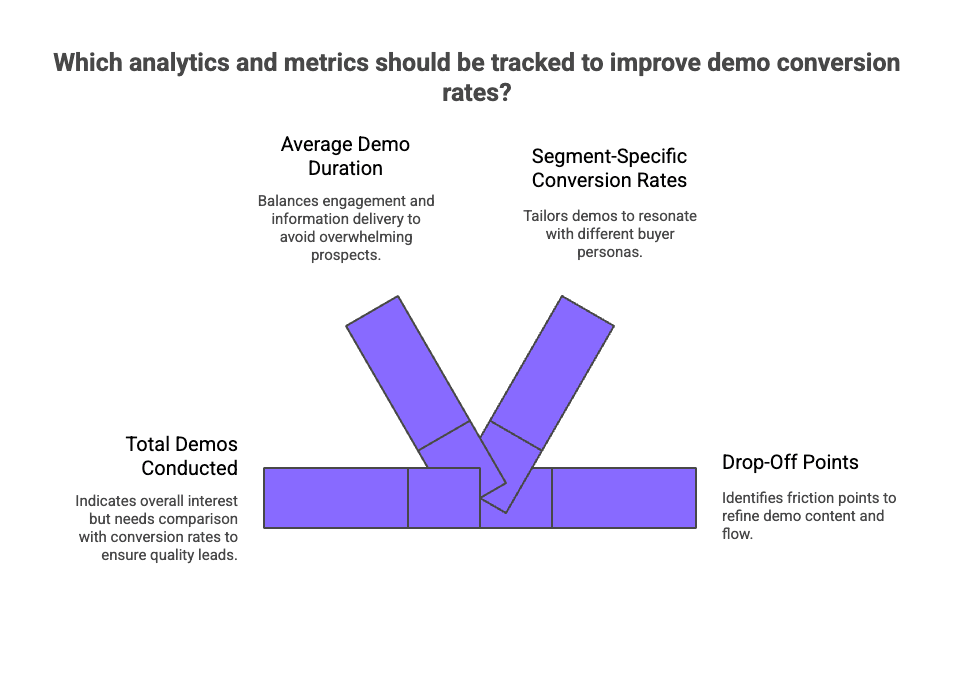
If you want to boost demo conversion rates, you can’t rely on gut feel; you need data. Tracking the right metrics helps you understand what’s working, where prospects lose interest, and how to refine your approach for better outcomes. Small tweaks, guided by the numbers, often drive the biggest gains.
1. Total Demos Conducted
A rising number of demos signals strong interest at the top of the funnel. But don’t just count them, compare demo volume with conversion rates to ensure you’re attracting the right leads, not just more leads.
2. Average Demo Duration
Long demos often point to complexity or information overload, while short demos may fail to show enough value. Aim for a balance: just long enough to solve the prospect’s core problem and keep them engaged.
3. Segment-Specific Conversion Rates
Not all customers convert the same way. Tracking conversion by industry, company size, or role reveals where your message resonates most—and where it needs refining. This helps you tailor demos for different buyer personas.
4. Drop-Off Points
Pinpoint the exact stage where prospects disengage, whether that’s mid-demo, during Q&A, or after the follow-up. Each drop-off reveals friction you can address with better storytelling, clearer CTAs, or smoother next steps.
Also read:
If you're planning on translating your launch momentum into sales and growth, don’t miss our guide on How to Boost SaaS Demo Conversion Rates here.
What are the 11 Proven Tips to Boost SaaS Demo and Free Trial Conversions?
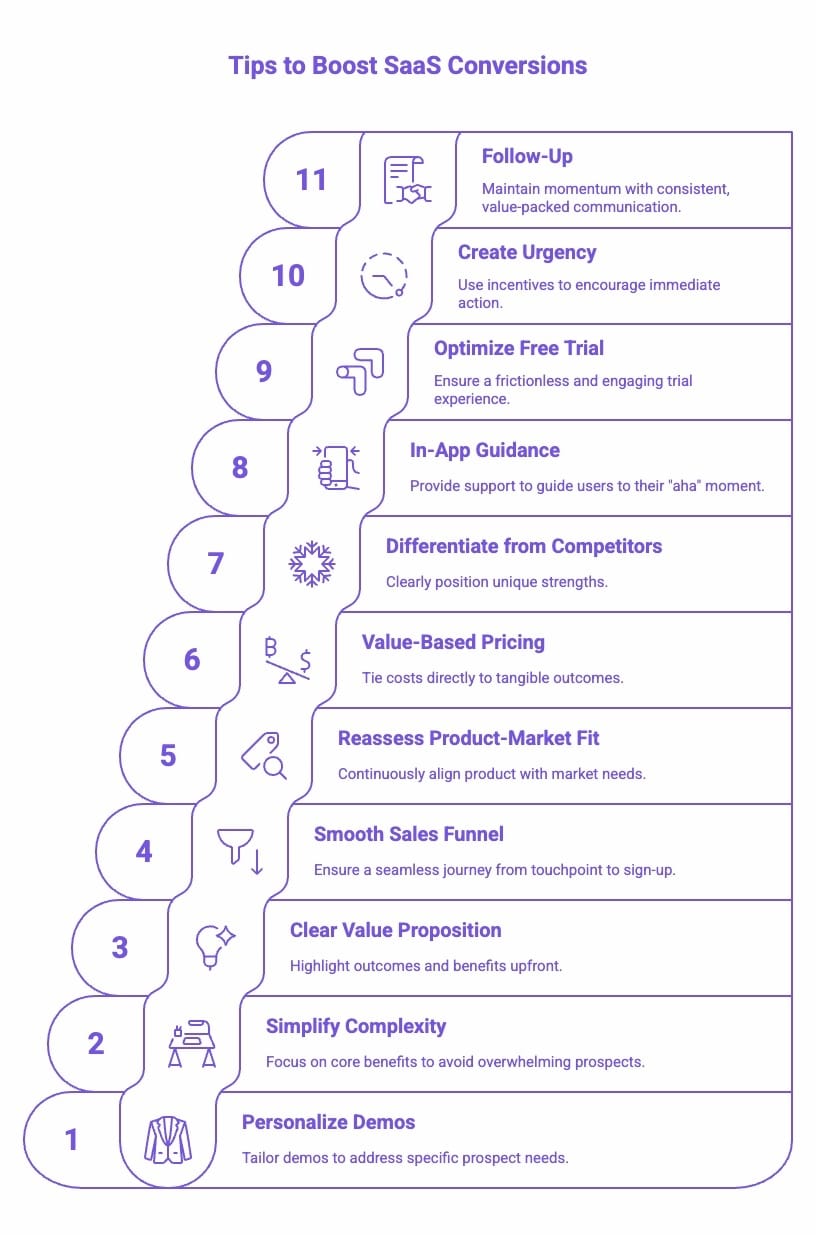
Whether you’re running demos or offering free trials, the goal is the same: deliver immediate, personalized value and make the next step obvious.
Here are nine proven strategies to turn more prospects into paying customers:
1. Personalize Every Demo
A one-size-fits-all demo is like a mass email blast, easy to ignore. Research your prospect’s industry, challenges, and role, then highlight how your product solves their specific pain points. A tailored demo always converts better than a generic tour.
2. Simplify Complexity
Overwhelming prospects with features kills interest. Keep demos streamlined by focusing on core benefits and real-world impact. Show how your SaaS makes life easier, not harder.
3. Lead with a Clear Value Proposition
If prospects don’t immediately see why your product is the better solution, they’ll check out. Spotlight the outcomes, time saved, costs reduced, workflows improved, not just the features.
4. Build a Smooth Sales Funnel
Friction kills conversions. From first touchpoint to demo to sign-up, the journey should feel effortless. Use content that builds curiosity, deliver demos that spark excitement, and provide clear, easy next steps.
5. Reassess Product-Market Fit Regularly
If conversion rates drop, it may not be your pitch; it could be your product. Customer needs evolve quickly. Continuously track industry shifts, competitor updates, and feedback to keep your demo messaging aligned with what matters now for your target market.
6. Show ROI Through Value-Based Pricing
Prospects hesitate when pricing feels abstract. Tie cost directly to outcomes, efficiency gains, revenue growth, or cost savings. When ROI is obvious, the price becomes an easy decision.
7. Differentiate from Competitors
Prospects are comparing you with alternatives. Clearly position your strengths and unique advantages. Real-world use cases or success stories make differentiation even stronger.
8. Use In-App Guidance and Interactive Walkthroughs
Don’t leave prospects to figure things out. Use onboarding checklists, interactive walkthroughs, and real-time support to guide them toward their “aha” moment. The faster they see value, the more likely they are to convert.
9. Optimize Your Free Trial Experience
Your free trial is often the final push before conversion. To make it work:
Keep sign-up frictionless (no endless forms or credit card upfront).
Use sharp, personalized email marketing to keep users engaged.
Provide in-app checklists and support so users never feel lost.
10. Create Urgency
Prospects delay decisions when there’s no reason to act now. Use limited-time offers, fast-track onboarding, or time-sensitive incentives to move them from “interested” to “committed” faster.
11. Follow-Up
Most conversions happen after the demo, not during. Send tailored recaps, handle objections, and keep momentum alive with consistent, value-packed follow-ups that show you understand their priorities.
Make Your Product the Obvious Choice in Every Demo With SmartCue
Most SaaS teams spend hours booking demos, only to watch prospects nod politely and disappear afterward. Why? Because generic, one-size-fits-all demos don’t close. They educate, but they don’t convert.
SmartCue flips that script.
With SmartCue, your sales team delivers demos that feel like they were built just for the buyer. Instead of overwhelming prospects with every feature, you guide them straight to the moments that matter, the features that solve their problem, in their language, at the exact time they need to see it.
Here’s what that means for you:
Higher Win Rates – Personalized demos resonate, making buying decisions faster and easier.
Shorter Sales Cycles – Tailored messaging and interactive walkthroughs cut out confusion and delay.
Better Predictability – Data-backed insights on engagement, drop-offs, and follow-ups help you forecast revenue with confidence.
No Wasted Leads – Every demo becomes a high-impact, ROI-driven conversation.
SmartCue doesn’t just make demos prettier; it makes them profit centers. When every interaction highlights business value, prospects stop window-shopping and start signing.
👉 If you’re tired of chasing leads that go nowhere, it’s time to stop guessing and start converting.
Sign up for your SmartCue demo today →
Conclusion
At the end of the day, your SaaS demo is a bit like a first date. Show up late, talk only about yourself, and forget to listen, and well, you won’t be hearing from them again. But nail the personalization, keep things engaging, and make the next step obvious? That’s when sparks fly.
Remember: average conversion rates are just averages. You don’t want to be “average.” You want to be the story your prospect tells their team after the call, the one that made them think, “Finally, a product that gets us.”
So tighten up your demo, polish that onboarding process, and maybe skip asking for credit card information on the first “date.” With the right strategy (and maybe a little SmartCue magic), you’ll turn demo crickets into demo commitments, and that’s a happily-ever-after worth converting for.
Frequently Asked Questions
What is a good demo conversion rate for a SaaS company?
A good demo conversion rate for a SaaS company varies, but as per SaaS industry standards, most businesses aim for about 15%-30%, which aligns with the average demo conversion rate for the industry. However, top-performing firms often outperform these standards, reporting even higher rates.
How do I track and analyze my SaaS demo conversion rate?
Keep a record of how many demos you've conducted and note how many customers moved from a demo to a purchase. Dividing the number of demo-to-paid users by the total number of demos will yield your demo conversion rate.
Can my SaaS business thrive with a low demo conversion rate?
Yes, while a higher demo conversion rate is preferable, a SaaS business with a solid retention or up-selling strategy can still thrive even with a lower conversion rates demo conversion rate. It also depends on the size of the company and the nature of the product and market.
What aspects should I focus on to improve my demo conversion rate?
Focusing on personalization, a clear value proposition, an effective sales funnel, and potential customer needs can significantly improve your demo conversion rate. Other strategies include regular reassessments of product-market fit and the implementation of in-app guidance and interactive walkthroughs.
How can I ensure success for my SaaS business beyond demo conversions?
Ensuring success beyond demo conversions involves focusing on post-sales customer support, continuous product enhancements, value-based pricing, and cultivating robust relationships with customers through effective SaaS marketing strategies. Achieving high customer retention rates translates into overall success for any SaaS business.
How can I increase the conversion rate of my SaaS product demos?
You can increase demo conversion by personalizing presentations, improving the onboarding process, and aligning pricing with ROI. Track activation rate and trial conversion rate across each marketing channel to spot gaps. Comparing with different benchmarks ensures your approach beats average conversion rates.
How do I calculate the conversion rate from demo sign-ups to paying users in SaaS?
Divide the number of trial users who become paying customers by the total number of trial sign-ups. This gives your trial conversion rate. Using a clean data set with accurate contact information helps ensure reliable insights. Compare your figure with median conversion rate values to see where you stand.
Can gamification improve SaaS demo conversion rates?
Yes. Gamified elements like progress bars, rewards, or badges can optimize game demo conversion rate by keeping users engaged through the onboarding process. Higher activation rate during the trial period often leads to stronger free trial conversion rate numbers.
How does landing page design affect SaaS demo conversion rates?
A clear landing page with strong CTAs and minimal friction boosts landing page conversion rates. Avoid asking for unnecessary credit card information upfront. What is a good conversion rate for a landing page? Benchmarks vary, but top designs outperform average conversion rates by focusing on clarity and user intent.
What factors most influence demo conversion rates for SaaS businesses?
Key drivers include the quality of the onboarding process, relevance of messaging to the data set of prospects, and strength of follow-up. Marketing channel choice, the number of trial users, and whether you require credit card information also directly affect B2B SaaS conversion rate benchmarks.
What are common mistakes that reduce demo conversion rates in SaaS?
Common pitfalls include generic demos, confusing onboarding, and asking for contact information too early. Ignoring trial user feedback, failing to measure the number of trial completions, and overlooking B2B SaaS conversion rate benchmarks often result in lower SaaS conversion outcomes compared to the median conversion rate.

